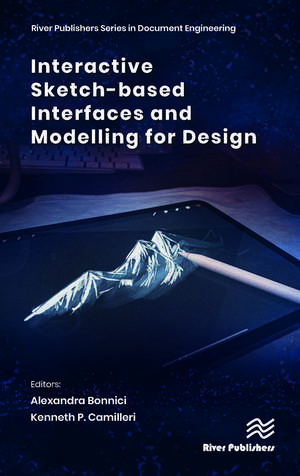Interactive Sketch-based Interfaces and Modelling for Design
Editat de Alexandra Bonnici, Kenneth P. Camillerien Limba Engleză Hardback – 31 mai 2023
The book is divided into two parts. The first part focuses on sketching in the 2D domain. This includes the digitization of offline and paperbased sketches, techniques for online sketch recognition, observations of user drawing habits, algorithms for inferring depth from 2D drawings, as well as non-photorealistic rendering techniques that are then applied to sketch-based queries. The second part of the book focuses on 3D sketching in virtual or augmented reality spaces. Here, we present the processing and rendering of the 3D strokes, the different interaction devices available for 3D sketching, and look at different applications where immersive 3D sketching has been applied with success.
Preț: 827.30 lei
Preț vechi: 1034.11 lei
-20% Nou
Puncte Express: 1241
Preț estimativ în valută:
158.30€ • 172.49$ • 133.39£
158.30€ • 172.49$ • 133.39£
Carte tipărită la comandă
Livrare economică 23 aprilie-07 mai
Preluare comenzi: 021 569.72.76
Specificații
ISBN-13: 9788770227704
ISBN-10: 8770227705
Pagini: 302
Ilustrații: 22 Line drawings, color; 4 Line drawings, black and white; 63 Halftones, color; 13 Halftones, black and white; 85 Illustrations, color; 17 Illustrations, black and white
Dimensiuni: 156 x 234 x 18 mm
Greutate: 0.72 kg
Ediția:1
Editura: River Publishers
Colecția River Publishers
ISBN-10: 8770227705
Pagini: 302
Ilustrații: 22 Line drawings, color; 4 Line drawings, black and white; 63 Halftones, color; 13 Halftones, black and white; 85 Illustrations, color; 17 Illustrations, black and white
Dimensiuni: 156 x 234 x 18 mm
Greutate: 0.72 kg
Ediția:1
Editura: River Publishers
Colecția River Publishers
Notă biografică
Alexandra Bonnici received her B.Eng. (Hons) in 2004, M.Phil. (Melit.) in Engineering in 2008 and Ph.D. (Melit.) in 2015 on work related to the vectorization and interpretation of sketches with artistic cues. Alexandra’s research work is the fields of computer vision and machine learning. Specific research interests include the machine interpretation of drawings and sketches, text, and music document processing, as well as the development of applications that assist the teaching and learning of music. Alexandra is a Senior Lecturer at the University of Malta and is currently serving as Head of Department of the Department of Systems and Control Engineering. She is also the coordinator of the Faculty’s Certificate in Engineering Sciences. She is also active in promoting STEM education, having set up the Engineering Technology Clubs at the Faculty of Engineering. Alexandra is a Senior Member of the Institute of Electronic and Electrical Engineers (IEEE, USA), a member of the Association for Computing Machinery (ACM, USA) and the Eurographics Association. She is also a steering committee member of the ACM Symposium on Document Engineering.
Professor Kenneth P. Camilleri graduated with a B.Elec.Eng. (Hons) degree in electrical engineering from the University of Malta in 1991, an M.Sc. in Signal Processing and Machine Intelligence, and Ph.D. degrees from the University of Surrey, UK in 1994 and 1999, respectively. Professor Camilleri’s research work is in the fields of signal processing, computer vision and machine learning. His specific research interests include automatic drawing interpretation, eye gaze tracking, human computer interfacing based on electrophysiological signals such as the electroencephalogram (EEG) and the electrooculogram (EOG), and biomedical signal and image analysis for physiological measurement and the extraction of disease biomarkers. He has published research in these areas in over 160 international peer-reviewed publications. Professor Camilleri is a founding member of the Department of Systems and Control Engineering, and of the Centre for Biomedical Cybernetics, both at the University of Malta. He presently serves as Director of the Centre for Biomedical Cybernetics. Professor Camilleri is a Senior Member of the Institute of Electronic and Electrical Engineers (IEEE, USA), the Society for Photo-Optical Instrumentation Engineering (SPIE, USA), and the Association for Computing Machinery (ACM, USA), and a member of the Institution of Engineering and Technology (IET, UK).
Professor Kenneth P. Camilleri graduated with a B.Elec.Eng. (Hons) degree in electrical engineering from the University of Malta in 1991, an M.Sc. in Signal Processing and Machine Intelligence, and Ph.D. degrees from the University of Surrey, UK in 1994 and 1999, respectively. Professor Camilleri’s research work is in the fields of signal processing, computer vision and machine learning. His specific research interests include automatic drawing interpretation, eye gaze tracking, human computer interfacing based on electrophysiological signals such as the electroencephalogram (EEG) and the electrooculogram (EOG), and biomedical signal and image analysis for physiological measurement and the extraction of disease biomarkers. He has published research in these areas in over 160 international peer-reviewed publications. Professor Camilleri is a founding member of the Department of Systems and Control Engineering, and of the Centre for Biomedical Cybernetics, both at the University of Malta. He presently serves as Director of the Centre for Biomedical Cybernetics. Professor Camilleri is a Senior Member of the Institute of Electronic and Electrical Engineers (IEEE, USA), the Society for Photo-Optical Instrumentation Engineering (SPIE, USA), and the Association for Computing Machinery (ACM, USA), and a member of the Institution of Engineering and Technology (IET, UK).
Cuprins
1 Introduction I Sketches Drawn on 2D Media 2 Simplification and Vectorization of Sketched Drawings 3 Online Interpretation of Sketched Drawings 4 Reconstruction from Sketched Drawings 5 Reconciling Search Results with User Sketches II 3D Sketching 6 Introduction to 3D Sketching 7 Input Processing and Geometric Representations for 3D Sketches 8 Interaction Devices and Techniques for 3D Sketching 9 3D Sketching Application Scenarios 10 Conclusions
Descriere
This book is divided into two parts. The first part focuses on sketching in the 2D domain, and the second part focuses on 3D sketching in virtual or augmented reality spaces.
